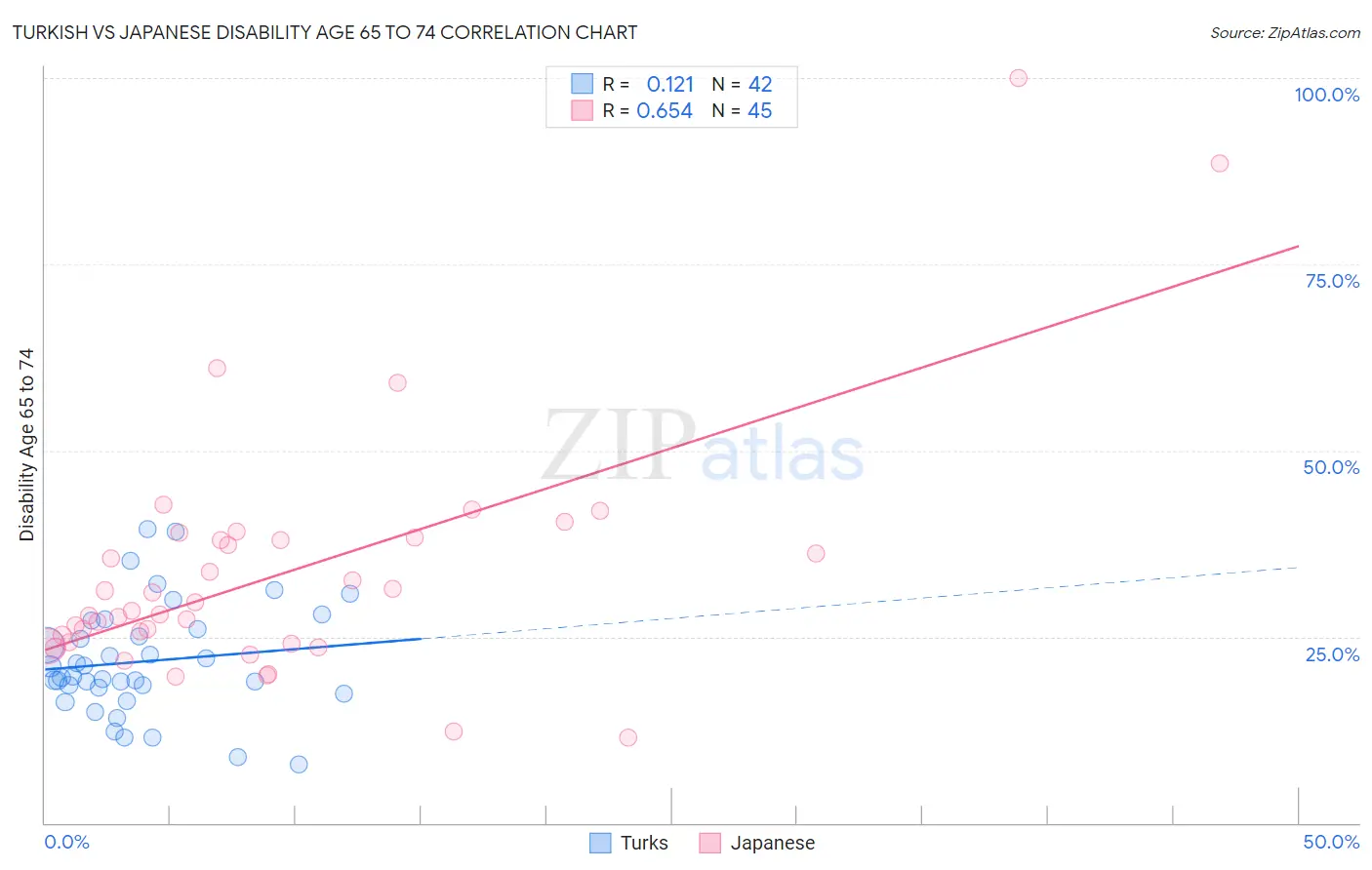Turkish vs Japanese Disability Age 65 to 74
COMPARE
Turkish
Japanese
Disability Age 65 to 74
Disability Age 65 to 74 Comparison
Turks
Japanese
21.0%
DISABILITY AGE 65 TO 74
99.9/ 100
METRIC RATING
32nd/ 347
METRIC RANK
25.7%
DISABILITY AGE 65 TO 74
0.1/ 100
METRIC RATING
273rd/ 347
METRIC RANK
Turkish vs Japanese Disability Age 65 to 74 Correlation Chart
The statistical analysis conducted on geographies consisting of 271,478,779 people shows a poor positive correlation between the proportion of Turks and percentage of population with a disability between the ages 65 and 75 in the United States with a correlation coefficient (R) of 0.121 and weighted average of 21.0%. Similarly, the statistical analysis conducted on geographies consisting of 248,828,802 people shows a significant positive correlation between the proportion of Japanese and percentage of population with a disability between the ages 65 and 75 in the United States with a correlation coefficient (R) of 0.654 and weighted average of 25.7%, a difference of 22.3%.

Disability Age 65 to 74 Correlation Summary
| Measurement | Turkish | Japanese |
| Minimum | 7.9% | 11.5% |
| Maximum | 39.4% | 100.0% |
| Range | 31.5% | 88.5% |
| Mean | 21.7% | 33.5% |
| Median | 19.6% | 28.5% |
| Interquartile 25% (IQ1) | 18.2% | 24.2% |
| Interquartile 75% (IQ3) | 26.0% | 38.1% |
| Interquartile Range (IQR) | 7.8% | 13.9% |
| Standard Deviation (Sample) | 7.4% | 16.5% |
| Standard Deviation (Population) | 7.3% | 16.4% |
Similar Demographics by Disability Age 65 to 74
Demographics Similar to Turks by Disability Age 65 to 74
In terms of disability age 65 to 74, the demographic groups most similar to Turks are Immigrants from Northern Europe (21.0%, a difference of 0.030%), Immigrants from Greece (21.0%, a difference of 0.070%), Immigrants from Japan (21.0%, a difference of 0.11%), Immigrants from Czechoslovakia (21.0%, a difference of 0.15%), and Immigrants from Argentina (21.1%, a difference of 0.20%).
| Demographics | Rating | Rank | Disability Age 65 to 74 |
| Bolivians | 99.9 /100 | #25 | Exceptional 21.0% |
| Immigrants | Australia | 99.9 /100 | #26 | Exceptional 21.0% |
| Immigrants | Sweden | 99.9 /100 | #27 | Exceptional 21.0% |
| Immigrants | Czechoslovakia | 99.9 /100 | #28 | Exceptional 21.0% |
| Immigrants | Japan | 99.9 /100 | #29 | Exceptional 21.0% |
| Immigrants | Greece | 99.9 /100 | #30 | Exceptional 21.0% |
| Immigrants | Northern Europe | 99.9 /100 | #31 | Exceptional 21.0% |
| Turks | 99.9 /100 | #32 | Exceptional 21.0% |
| Immigrants | Argentina | 99.9 /100 | #33 | Exceptional 21.1% |
| Immigrants | Sri Lanka | 99.9 /100 | #34 | Exceptional 21.1% |
| Bulgarians | 99.9 /100 | #35 | Exceptional 21.1% |
| Immigrants | Switzerland | 99.8 /100 | #36 | Exceptional 21.1% |
| Israelis | 99.8 /100 | #37 | Exceptional 21.2% |
| Russians | 99.8 /100 | #38 | Exceptional 21.2% |
| Argentineans | 99.8 /100 | #39 | Exceptional 21.2% |
Demographics Similar to Japanese by Disability Age 65 to 74
In terms of disability age 65 to 74, the demographic groups most similar to Japanese are Immigrants from Liberia (25.7%, a difference of 0.13%), Immigrants from Dominica (25.7%, a difference of 0.13%), Immigrants from Guatemala (25.7%, a difference of 0.16%), Hmong (25.7%, a difference of 0.24%), and American (25.8%, a difference of 0.33%).
| Demographics | Rating | Rank | Disability Age 65 to 74 |
| Immigrants | Latin America | 0.1 /100 | #266 | Tragic 25.6% |
| Ottawa | 0.1 /100 | #267 | Tragic 25.6% |
| Liberians | 0.1 /100 | #268 | Tragic 25.6% |
| Hmong | 0.1 /100 | #269 | Tragic 25.7% |
| Immigrants | Guatemala | 0.1 /100 | #270 | Tragic 25.7% |
| Immigrants | Liberia | 0.1 /100 | #271 | Tragic 25.7% |
| Immigrants | Dominica | 0.1 /100 | #272 | Tragic 25.7% |
| Japanese | 0.1 /100 | #273 | Tragic 25.7% |
| Americans | 0.1 /100 | #274 | Tragic 25.8% |
| Hondurans | 0.1 /100 | #275 | Tragic 25.8% |
| French American Indians | 0.1 /100 | #276 | Tragic 25.8% |
| Belizeans | 0.1 /100 | #277 | Tragic 25.8% |
| Immigrants | Belize | 0.1 /100 | #278 | Tragic 25.8% |
| U.S. Virgin Islanders | 0.1 /100 | #279 | Tragic 25.9% |
| Cree | 0.1 /100 | #280 | Tragic 25.9% |